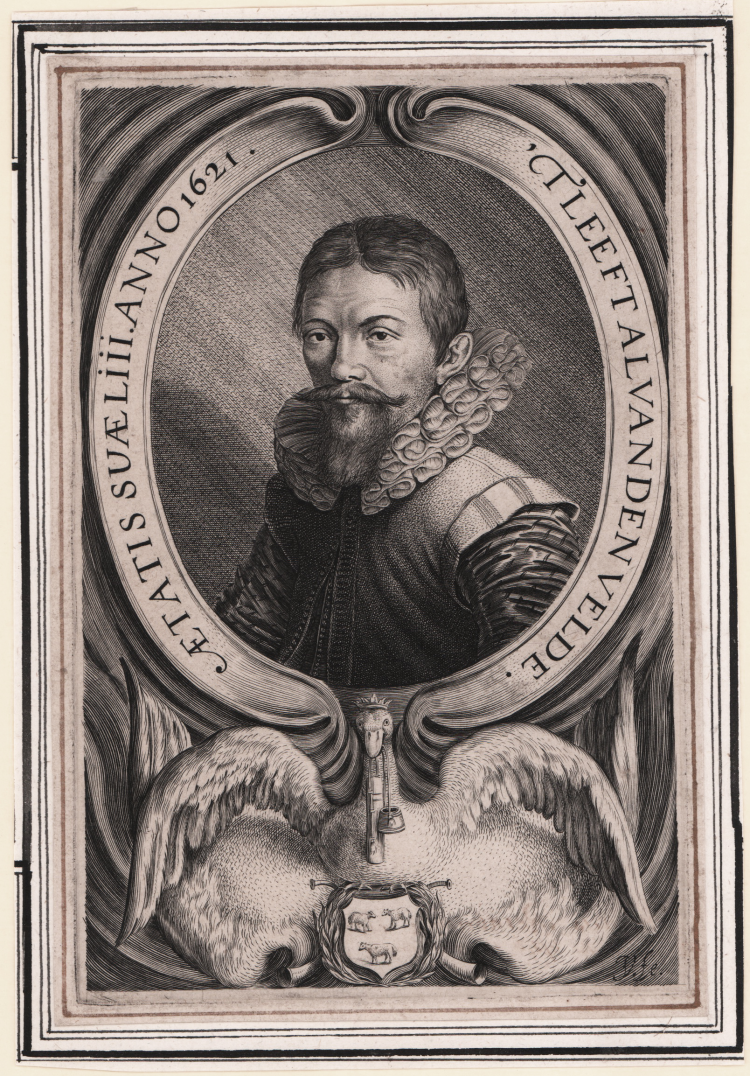



| Reference: | S12564 |
| Author | Jan van de VELDE II |
| Year: | 1621 |
| Measures: | 110 x 165 mm |


| Reference: | S12564 |
| Author | Jan van de VELDE II |
| Year: | 1621 |
| Measures: | 110 x 165 mm |
Engraving, 1621, signed with monogram on right plate.
Magnificent work, printed on contemporary laid paper, with small margins, laid on antique collector’s paper, in excellent condition.
Portrait of Jan van de Velde the Elder in an oval frame; below a crowned swan holding a pencil case in its beak; at lower centre the sitter's arms with three sheep.
Lettered on the oval frame: 'T LEEFT AL VAN DE VELDE AETATIS SUAE LIII ANNO 1621'.
And signed in bottom right corner: 'JV fe.'
Rare.
|
Franken & van der Kellen 40.41; Hollstein 414.II.
|
Jan van de VELDE II (Delft 1593 - Enkhuizen 1641)
|
Jan van de Velde II, or Veldius (Delft or Rotterdam, 1593 - Enkhuizen, October 24, 1641 (buried November 4), was a Dutch engraver, painter, draftsman and publisher of the Golden Century. Son of Jan van de Velde, father of Jan van de Velde III and grandson of Esaias van de Velde, he spent his youth in Rotterdam and was a pupil of Jacob Matham in Haarlem. In this city he began his artistic career, becoming a member of the local Guild of Saint Luke in 1614. In 1618 he worked in Enkhuizen, while in 1626 he was in Haarlem: in fact he became a member of the Calvinist Church in that year. In 1636 he moved to Enkhuizen, where he remained until 1641. He traveled through the Lower Rhine region along the Niers River, stopping in Schenkenschans, near Kleve and Düren. He devoted himself mainly to the representation of landscapes, especially winter, religious subjects and genre, often portraying peasants, architecture, interiors and portraits. He is best known as an engraver, but was also active as a painter. Unfortunately, his paintings are difficult to identify: only a winter landscape of oval shape and signed with the monogram IVV has been attributed to him. He also produced prints in series, from the beginning of his career, creating his own brand as a printer. He also made prints of devotion. He was among the most prolific engravers of Haarlem, realizing, as early as 1617, more than a hundred landscapes, emphasizing naturalistic details and simply structuring the compositions. He also executed more than fifty portraits, genre scenes and book illustrations. In the later stage of his career, he also produced engravings based on the works of other artists, including those of his cousin Esaias van de Velde II. He contributed to create, along with other artists who worked in Haarlem, the typical Dutch landscape of the seventeenth century, highlighting features, previously ignored. Were formed at his school Willem Akersloot, Cornelis Goutsbloem, Cornelis van Kittensteyn and Jan van de Velde III. His works influenced Esaias van de Velde and Rembrandt.
|
|
Franken & van der Kellen 40.41; Hollstein 414.II.
|
Jan van de VELDE II (Delft 1593 - Enkhuizen 1641)
|
Jan van de Velde II, or Veldius (Delft or Rotterdam, 1593 - Enkhuizen, October 24, 1641 (buried November 4), was a Dutch engraver, painter, draftsman and publisher of the Golden Century. Son of Jan van de Velde, father of Jan van de Velde III and grandson of Esaias van de Velde, he spent his youth in Rotterdam and was a pupil of Jacob Matham in Haarlem. In this city he began his artistic career, becoming a member of the local Guild of Saint Luke in 1614. In 1618 he worked in Enkhuizen, while in 1626 he was in Haarlem: in fact he became a member of the Calvinist Church in that year. In 1636 he moved to Enkhuizen, where he remained until 1641. He traveled through the Lower Rhine region along the Niers River, stopping in Schenkenschans, near Kleve and Düren. He devoted himself mainly to the representation of landscapes, especially winter, religious subjects and genre, often portraying peasants, architecture, interiors and portraits. He is best known as an engraver, but was also active as a painter. Unfortunately, his paintings are difficult to identify: only a winter landscape of oval shape and signed with the monogram IVV has been attributed to him. He also produced prints in series, from the beginning of his career, creating his own brand as a printer. He also made prints of devotion. He was among the most prolific engravers of Haarlem, realizing, as early as 1617, more than a hundred landscapes, emphasizing naturalistic details and simply structuring the compositions. He also executed more than fifty portraits, genre scenes and book illustrations. In the later stage of his career, he also produced engravings based on the works of other artists, including those of his cousin Esaias van de Velde II. He contributed to create, along with other artists who worked in Haarlem, the typical Dutch landscape of the seventeenth century, highlighting features, previously ignored. Were formed at his school Willem Akersloot, Cornelis Goutsbloem, Cornelis van Kittensteyn and Jan van de Velde III. His works influenced Esaias van de Velde and Rembrandt.
|